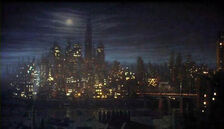
Gotham City's skyline, as it appears in the 1989 Batman movie.
Batman (1989 film)[]
In the opening lines of the Sam Hamm screenplay to the 1989 film version[1], Gotham is described as Hell erupted through the pavement and built a city (similar to a Pandæmonium, or the capital of Hell, from the terms of John Milton). The logic in screenplay is when elevators were utilized for taller structures, the buildings over a few stories were built around the existing structures of Gotham Town. These skyscapers cast a shadow over the city coupled with the smoke from Gotham's industry kept the city in perpetual dusk.
A map of Gotham City used in the film Batman (1989) was actually an inverted map of Vancouver, British Columbia, Canada. In the same movie, a map of the Axis Chemical plant was actually a map of the Capitol Hill neighborhood in Burnaby, British Columbia, Canada.
Anton Furst did the production design for the first Batman film directed by Tim Burton[2][3]. Anton Furst's set designs for the Batman movie were an attempt to imagine what might have happened to New York City had there been no planning commission and had it been run by pure extortion and crime. Hence, there were no height restrictions, the skyscrapers were cantilevered toward the street rather than away, there were lots of bridges over the streets. In return, the city appeared to be extremely dark and claustrophobic. Burton even stated himself that his take on Gotham was "As if Hell came sprouting out of the concrete and kept right on growing."
The individual buildings in Furst's version of Gotham were based on a whole host of influences. The cathedral was based on Antoni Gaudí's Sagrada Família, the Flugelheim Museum exterior was based on the work of Shin Takamatsu, and some of the other influences were Otto Wagner, Norman Foster, and Albert Speer.[4] In essence, Furst deliberately mixed clashing architectural styles to make Gotham City the ugliest and bleakest metropolis imaginable.
For Wayne Manor, Knebworth House, a Gothic Tudor mansion 28 miles north of London was used for the exterior. The interior however, is Hatfield House, Hertfordshire.
The flag of Gotham City closely resembles the state flag of Indiana. It can be seen briefly in Harvey Dent's office.
Batman Returns[]
For Tim Burton's second Batman film, Batman Returns[5][6] (1992), Bo Welch took over the production design[7] duties from Anton Furst. Welch for the most part, based his designs on Furst's concepts.[8] Whereas Anton Furst's designs showed a considerable amount of sinister visual grandeur, Bo Welch's designs had a more whimsical approach.[9][10][11] Welch blended "Fascist architecture with World's Fair architecture" for Gotham City.[12] Russian architecture and German Expressionism were also studied.
At least 50% of the Warner Brothers lot was taken up with Gotham City sets. The massive Gotham City sets were all constructed to be mobile, and were often shifted between days of filming. Michelle Pfeiffer (Catwoman) routinely got lost on her way to filming each day.
References[]
- ↑ Film locations for Batman
- ↑ Gotham City (Burton films) - Batman Wiki
- ↑ Equally important to the success of the film is Burton's dark and surreal visual style. He creates a Gotham City that is scary, cartoonish and imposing all at the same time.
- ↑ Comic Book Resources Forums - View Single Post - Gotham City Architecture Influences
- ↑ Film locations for Batman Returns
- ↑ Batman Returns - Gotham City
- ↑ SETS APPEAL: DESIGNING 'BATMAN RETURNS'
- ↑ Lensed seemingly entirely indoors or on covered sets, pic is a magnificently atmospheric elaboration on German expressionism. Its look has been freshly imagined by production designer Bo Welch, based on the Oscar-winning concepts of the late Anton Furst in the first installment. Welch's Gotham City looms ominously over all individuals, and every set--from Penguin's aquarium-like lair and Shreck's lavish offices to Bruce Wayne's vaguely "Citizen Kane"-like mansion and simple back alleys--is brilliantly executed to maximum evocative effect.
- ↑ And the sinister visual grandeur of the late Anton Furst has given way to the more whimsical approach
- ↑ The sets by Bo Welch are amazing, a Teutonic, "Metropolis"-like Gotham -- perfect to house the larger than life characters.
- ↑ The three-way story, involving Keaton's Batman, DeVito's Penguin and Pfeiffer's Catwoman, takes place in a wonderland of moody sets by Bo Welch.
- ↑ Judy Sloane (August 1995). "Bo Welch Interview", Film Review, pp. 66. Retrieved on 2008-08-14.
External links[]
- Bat Locations, a detailed list of locations used for the 1960s Batman show.
- Gotham City History and Notable Locations from the Batman 1960s TV show, a list of locations that appeared in the 1960s Batman show.
- Gotham City's article at Pop-Cult Guides, complete with sourced maps and lists of locations, etc.
- Gotham City - DC Database
- Feature: Gotham City, A Visual History